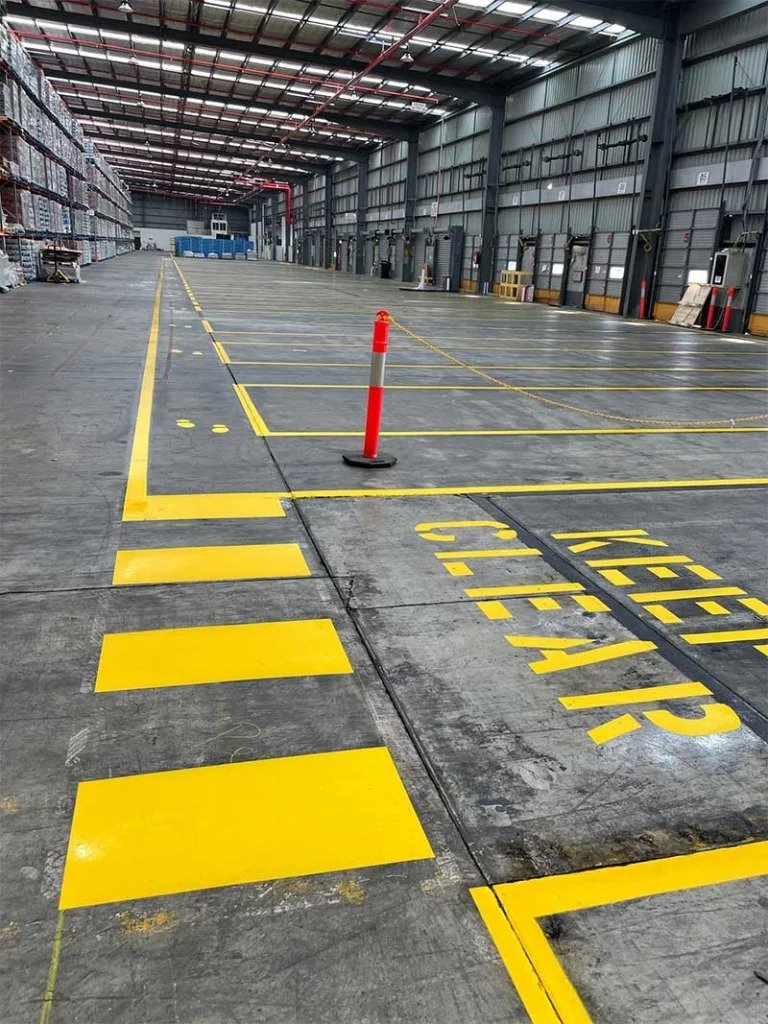When you step into a busy Melbourne warehouse, one of the first things you’ll notice is the colourful lines, symbols, and markings on the floor. These aren’t just for show but they’re essential for safety, efficiency, and legal compliance. If you’re a warehouse manager or business owner, getting your line marking right can make a huge difference in how your facility operates. Here’s everything you need to know about warehouse line marking in Melbourne, from the basics to expert tips.
Why Warehouse Line Marking Is So Important
Warehouses are dynamic environments where people, forklifts, trucks, and goods are constantly on the move. Without clear guidance, chaos can quickly take over. Proper line marking helps by:
- Separating Pedestrian and Vehicle Traffic: Dedicated walkways keep workers safe from forklifts and other vehicles.
- Defining Storage and Work Zones: Marked areas for pallets, racking, and machinery help prevent clutter and confusion.
- Highlighting Hazards: Bright colours and warning symbols draw attention to dangerous areas, reducing the risk of accidents.
- Improving Workflow: Clear routes and zones help everyone know where to go and what to do, boosting productivity.
Understanding Australian Standards
Warehouse Line Marking in Melbourne must comply with strict Australian Standards and Occupational Health & Safety (OH&S) regulations. Key standards include:
- AS 1742.2: Covers road and traffic markings, including warehouse applications.
- AS 4084: Relates to racking and storage systems.
- OH&S Regulations: Require employers to provide a safe workplace, which includes clear traffic management and hazard identification.
These standards specify everything from line colours and widths to the placement of symbols and the type of paint used.
Key Areas for Warehouse Line Marking
Every warehouse is different, but most facilities need line marking in these critical areas:
1. Pedestrian Walkways
- Colour: Usually yellow or white for high visibility.
- Purpose: Guide foot traffic safely through the warehouse, away from vehicles and machinery.
- Features: May include zebra crossings, arrows, and “Walk Only” symbols.
2. Forklift and Vehicle Routes
- Colour: Often red, blue, or green, depending on the site’s traffic management plan.
- Purpose: Clearly separates vehicle lanes from pedestrian areas to prevent collisions.
- Features: Directional arrows, speed limits, and stop lines.
3. Storage and Racking Bays
- Colour: White or yellow lines outline storage spaces for pallets and goods.
- Purpose: Prevents goods from blocking aisles or emergency exits.
- Features: Numbered bays or labels for easy inventory management.
4. Hazard and Exclusion Zones
- Colour: Red or black/yellow stripes.
- Purpose: Warns of dangerous areas like loading docks, chemical storage, or areas near heavy machinery.
- Features: Hazard symbols, “No Entry” signs, or cross-hatched zones.
5. Emergency Exits and Equipment
- Colour: Green for emergency pathways, red for fire equipment locations.
- Purpose: Ensures exits and safety equipment are always accessible and easy to find.
- Features: “Exit” arrows, fire extinguisher symbols, and clear access paths.
Materials and Techniques
For long-lasting, safe, and visible markings, professionals use:
- Industrial-Grade Paints: UV-resistant, quick-drying, and non-slip for safety in all conditions.
- Thermoplastic Markings: Extra durable and ideal for high-traffic areas.
- Epoxy Coatings: Used for areas exposed to chemicals or heavy wear.
- Reflective Additives: Improve visibility in low-light conditions or at night.
Correct surface preparation is crucial—cleaning, degreasing, and sometimes grinding the floor ensure the markings bond properly and last longer.
Best Practices for Warehouse Line Marking in Melbourne
- Plan Your Layout: Map out traffic flows, storage zones, and hazard areas before marking. Involve staff in the planning process for practical insights.
- Follow Colour Codes: Stick to standard colours for different zones to avoid confusion.
- Regular Maintenance: Inspect markings regularly and refresh faded lines to stay compliant and safe.
- Custom Symbols and Signage: Use stencils for clear, consistent symbols like arrows, forklifts, or hazard warnings.
- Minimise Disruption: Schedule marking work during off-peak hours or shutdowns to avoid interrupting operations.
- Stay Up to Date: Review your line marking whenever you change your warehouse layout or introduce new equipment.
Common Mistakes to Avoid
- Using household paint or incorrect materials that wear out quickly
- Ignoring Australian Standards, leading to compliance issues
- Overcrowding the floor with too many lines or symbols, causing confusion
- Not marking hazard zones or emergency exits clearly
- Failing to involve staff in planning, resulting in impractical layouts
Why Choose Professional Line Marking?
DIY might seem cheaper, but professional line marking ensures:
- Compliance with all relevant standards and regulations
- Use of the right materials for durability and safety
- Precision and clarity in every line and symbol
- Minimal disruption to your business
- Expert advice on optimising your warehouse layout
The Western Suburbs Line Marking Difference
When it comes to Warehouse Line Marking in Melbourne, experience and local knowledge matter. Western Suburbs Line Marking brings years of expertise, high-quality materials, and a commitment to safety and compliance. Their team works with you to design, install, and maintain line markings that keep your warehouse running smoothly and safely, no matter the size or complexity of your operation.
